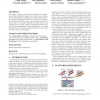Free Online Productivity Tools
i2Speak
i2Symbol
i2OCR
iTex2Img
iWeb2Print
iWeb2Shot
i2Type
iPdf2Split
iPdf2Merge
i2Bopomofo
i2Arabic
i2Style
i2Image
i2PDF
iLatex2Rtf
Sci2ools
126
click to vote
ISSS
2002
IEEE
2002
IEEE
Managing Dynamic Concurrent Tasks in Embedded Real-Time Multimedia Systems
This paper addresses the problem of mapping an application, which is highly dynamic in the future, onto a heterogeneous multiprocessor platform in an energy efficient way. A two-phase scheduling method is used for that purpose. By exploring the Pareto curves and scenarios generated at design time, the run-time scheduler can easily find a good scheduling at a very low overhead, satisfying the system constraints and minimizing the energy consumption. A real-life example from a 3D quality of service kernel is used to show the effectiveness of our method. Categories and Subject Descriptors D.4.7 [Operating Systems]: Organization and Design— real-time systems and embedded systems; D.4.1 [Operating Systems]: Processing Management; I.6.4 [Simulation and Modeling]: Model Validation and Analysis General Terms Design, Algorithms, Performance Keywords multiprocessor, embedded system, low-power, scheduling
Hardware | Heterogeneous Multiprocessor Platform | ISSS 2002 | Operating Systems | Two-phase Scheduling Method |
Related Content
| Added | 15 Jul 2010 |
| Updated | 15 Jul 2010 |
| Type | Conference |
| Year | 2002 |
| Where | ISSS |
| Authors | Rudy Lauwereins, Chun Wong, Paul Marchal, Johan Vounckx, Patrick David, Stefaan Himpe, Francky Catthoor, Peng Yang |
Comments (0)

